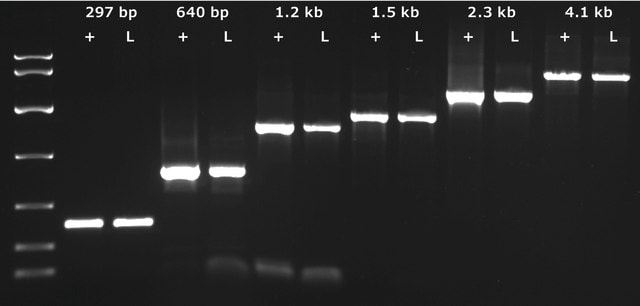TAQKB
Roche
KAPA Taq PCR Kit
Sinonimo/i:
PCR, Taq
About This Item
Prodotti consigliati
Durata
≤18 mo.
Livello qualitativo
Caratteristiche
dNTPs included: no
hotstart: no
Confezionamento
pkg of 250 U (KK1014)
pkg of 2500 U (BK1000)
pkg of 500 U (KK1015)
pkg of 5000 U (BK1002)
Produttore/marchio commerciale
Roche
tecniche
PCR: suitable
input
purified DNA
Temperatura di conservazione
−20°C
Cerchi prodotti simili? Visita Guida al confronto tra prodotti
Applicazioni
- High throughput PCR
- Amplification of low copy DNA templates
- Multiplex PCR
- Specific amplification of complex templates
- RT-PCR
- random amplified polymorphic DNA polymerase chain reaction (RAPD-PCR)
- Polymerase chain reaction (PCR)
- Genotyping
Azioni biochim/fisiol
Caratteristiche e vantaggi
- Improved sensitivity, specificity, and yields
- Novel buffer formulation facilitates specific primer annealing, leading to higher yield of specific product
Quick Notes:
- KAPA Taq DNA Polymerase can replace any commercial Taq DNA polymerase in an existing protocol.
- The final MgCl2 concentration may need to be optimized to account for differences in buffer formulation.
- KAPA Taq Buffers contain MgCl2 at a final concentration of 1.5 mM. Buffer A is recommended as first approach and for applications requiring high yields. Buffer B is recommended for applications where high sensitivity is required (e.g. when the template is limiting). Both buffers may be evaluated to determine the buffer most suitable for a specific application.
- The KAPA Taq PCR system is suitable for the amplification of fragments up to 3.5 kb from genomic DNA or 5 kb from less complex targets.
Qualità
Nota sulla preparazione
Altre note
Note legali
Solo come componenti del kit
- KAPA Taq Standard or HotStart® DNA Polymerase 5 U/μL
- 10X KAPA Taq Buffer A
- 10X KAPA Taq Buffer B
- MgCl2 25 mM
Codice della classe di stoccaggio
12 - Non Combustible Liquids
Classe di pericolosità dell'acqua (WGK)
WGK 1
Punto d’infiammabilità (°F)
does not flash
Punto d’infiammabilità (°C)
does not flash
Certificati d'analisi (COA)
Cerca il Certificati d'analisi (COA) digitando il numero di lotto/batch corrispondente. I numeri di lotto o di batch sono stampati sull'etichetta dei prodotti dopo la parola ‘Lotto’ o ‘Batch’.
Possiedi già questo prodotto?
I documenti relativi ai prodotti acquistati recentemente sono disponibili nell’Archivio dei documenti.
I clienti hanno visto anche
Articoli
An overview of directed evolution and the methods for generating proteins with optimized or entirely new functions.
Il team dei nostri ricercatori vanta grande esperienza in tutte le aree della ricerca quali Life Science, scienza dei materiali, sintesi chimica, cromatografia, discipline analitiche, ecc..
Contatta l'Assistenza Tecnica.









